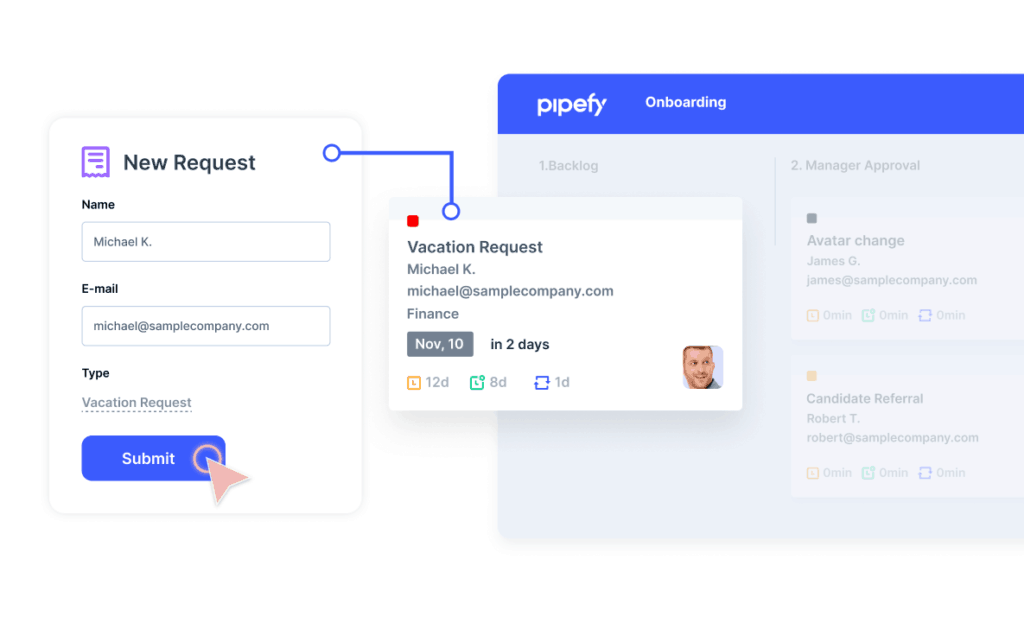
Everyone needs time away from work to have fun and recharge. After all, vacation time isn’t just good for employees’ wellbeing, it’s also good for business.
Tracking, organizing, and approving vacation requests is the responsibility of your human resources team. Requests must be processed efficiently and accurately, to allow for planning, coverage, and accounting. But this can be a challenge in some HR departments, especially in companies with a large number of employees, or for organizations that are growing quickly.
Trying to manage vacation requests via email or spreadsheets can make matters worse. In this article, we’ll look at the typical process for handling vacation requests, and some of the ways these processes can be improved, for both HR teams and employees.
1. Communicate your vacation policy during training
Communication is the foundation of any good relationship, and this is equally true when it comes to your employees. So it makes sense that the first step to managing vacation requests is to clearly communicate time-off guidelines to your employees.

Provide a copy of the policy to all new employees during onboarding, and ensure it’s easily available for future reference. (A common tactic is to include the policy in your employee handbook or company intranet. ) For some HR teams, having the employee sign an acknowledgment that they received the policy is a requirement.
If there are ever any changes to your vacation and PTO policy, you’ll need to communicate them to your entire team and be sure the updates are included wherever the policy is post
2. Be clear when employees can and can’t request time off
Just as people complain about blackout dates for cashing in their travel credit card points, blackout dates aren’t really a hit with employees either. But in some businesses, they’re a necessity.
If your company needs to enforce restrictions on when employees can request time off, make sure you do so with transparency and timeliness. This will make it easier to explain why blackout dates matter to your business, and increases buy-in on the part of your employees.
Communicate these dates as soon as possible, ideally to new hires during training. You should also include them in your employee handbook and anywhere else your time-off policy is listed. If you do require employees to work on specific dates, you may want to ask them to acknowledge their agreement in writing.
3. Set deadlines and limits for submitting requests
Team members should also know how far in advance they need to submit their vacation requests. Setting firm, clear deadlines gives managers enough time to review requests and balance schedules to ensure enough employees are still available to provide full coverage.
Deciding when to set your deadline depends on your business. Generally, though, deadlines range anywhere from two weeks up to as much as two months in advance.
Just as important as setting clear deadlines is setting clear limits on vacation time. In some cases, it may make sense to limit the actual number of requests or days off per year. However, some businesses might just restrict how many days off in a row an employee can take.
4. Establish a prioritization system for requests
You’ve communicated your company policy, including when employees can and can’t request vacation time, and how much of a heads up you’ll need. But what will you do if three employees request vacation for the same period of time?
Creating a system of prioritization will go a long way towards resolving these types of conflicts. Your prioritization system can be based on factors including:
- Seniority: Employees who’ve been with your company the longest get the first choice on taking time off for popular vacation times, such as three-day weekends or holidays.
- First come, first served: Approve requests for the first person to ask for specific periods off. Approve latecomers on a case-by-case basis. If you take this approach, you’ll need to make it clear how far in advance you will consider requests.
- Employee flexibility: Reward employees who are flexible about working during busy periods by prioritizing their off-peak season vacation requests. You’ll need to document and publicize this policy in order to encourage employees to volunteer.
- Manager’s discretion: You tend to know which employees work hardest and need encouragement to take a vacation, and which employees are more spontaneous. So in some cases, it may make sense to use your discretion to prioritize.

Be transparent about the reasons you might approve or deny employee vacation requests. Though workers might complain about not getting the days off they wanted, they won’t be able to say that you weren’t forthright in your process for handling competing requests.
5. Create an efficient, universal submission process
A solid policy and prioritization system, paired with clear communication, make for a great start in managing vacation and time-off requests. But no amount of policy-crafting and communication can save you from a messy submission process.
Relying on spreadsheets, email, or verbal requests might work for small teams, but this system does not scale and is difficult to control. A more effective approach is to create a standardized, consistent process for time-off requests.
Benefits of a defined vacation request process
- Eliminates the potential for missed or lost requests
- Ensures that the necessary information is provided
- Helps HR managers track request activity
- Makes it easier to document the request at each point in the process
- Helps you approve submissions quickly (and keep your employees happy!)
Example

6. Build a streamlined tracking system
Your submission request system is up and running. Employees are requesting vacation days and time off in accordance with your policy. Now, you’ll need a process for tracking and viewing all those vacation requests.
Software systems are a great way to simplify and organize the process of tracking vacation requests. Some programs’ strength lies in dynamic filtering options. For example, you may be able to sort requests by the date submitted, the dates requested off, the employee’s seniority, or the employee’s team or department, etc.
Some solutions also offer customization and flexibility in the structure of your process. For example, some programs will let you customize fill fields on the submission form to collect relevant information, such as the name of another employee who can cover the requester’s shift.
Deciding what features will be most useful for your human resources team will depend on many factors, including your industry, number of employees, and vacation policies. The end result should be a vacation request process that provides control, accuracy, and ease of implementation.
7. Reward employees who work during busy periods
Have you considered motivating employees to work during peak periods, when you need them the most? While some people will submit vacation requests for busy seasons a year in advance, others are happy to stick around and pitch in in exchange for some perks.
Try to determine a meaningful way to thank these employees for working during peak times. Maybe that’s extra PTO during off-peak periods, or higher pay during the rush. Another possibility could be to prioritize their future vacation requests.
| Tip: If you really want to find out what rewards are meaningful to your employees, ask them. They’ll appreciate you taking the time to listen and find out. |
8. Prepare for the unexpected with a backup plan
Even the most prepared HR manager will have to deal with unexpected vacation requests, absences, and their impact on your business. That’s why it’s important to have a backup plan you can turn to when the unforeseen arises.
For example, an increase in production or the addition of new projects of clients may overextend your existing resources, but you also want to avoid canceling vacations after they’ve been approved. One option would be to reach out to employees with active vacation requests to see who might have flexibility in their plans.
9. Plan for needs specific to your business
You’ll want your vacation policies to address the needs of your employees and your business. If your company employees specialized workers who can’t be easily replaced, you’ll want to consider this as you create your vacation guidelines.
For many businesses, this plan comes down to some tactics we’ve already mentioned, like figuring out which employees are flexible with their requests, or finding incentives that spur others to pitch in. For employees in retail or service industries, another strategy might be requiring the employee to help identify other employees who can cover their shifts.
Streamline your vacation request policy
Vacation requests are only one of many processes your human resources team has to manage. That’s why it’s important to build a process that’s organized and efficient. But you also want to make sure your process delivers consistency and control.
Pipefy helps people management processes. When it comes to vacation requests, that means automating repetitive tasks, increasing visibility, and delivering a great experience for your employees and your HR team.
Pipefy takes care of the process so you can focus on people.






